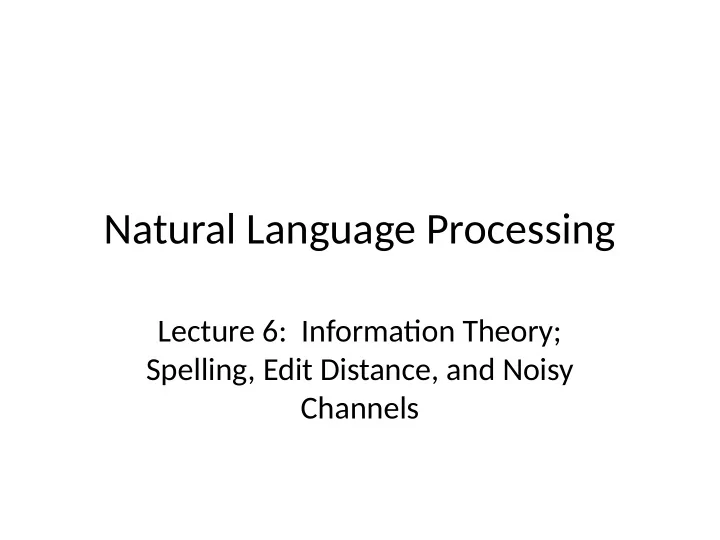

Natural Language Processing Lecture 6: Informaton Theory; Spelling, Edit Distance, and Noisy Channels
Language Models • Ngram models seem limited Must be something beter • What about grammar/semantcs? But we care more about ranking good Than ranking bad sentences • Most LM are looking a “nearly” good examples ● We care more about ranking near good ● Than ranking very bad examples
Neural Language Models • Not just previous local context What about future context • Not just local context What about words nearby • Neural models aren’t just about N -grams They care about more context if its helpful But you need lots of data to train from
Neural Language Models • BERT (ELMO) Contextualized word embedding Also a language model • GPT-2/GPT-3 A more general language model • Both using transformer neural models Trained on lots and lots of data • Give best LMs if their training model matches yours (ish)
A Taste of Informaton Theory • Shannon Entropy, H ( p ) • Cross-entropy, H ( p ; q ) • Perplexity
Codebook Horse Code Clinton 000 Edwards 001 Kucinich 010 Obama 011 Huckabee 100 McCain 101 Paul 110 Romney 111
Codebook Horse Code Probability Clinton 000 1/4 Edwards 001 1/16 Kucinich 010 1/64 Obama 011 1/2 Huckabee 100 1/64 McCain 101 1/8 Paul 110 1/64 Romney 111 1/64
Codebook Horse Probability New Code Clinton 1/4 10 Edwards 1/16 1110 Kucinich 1/64 111100 Obama 1/2 0 Huckabee 1/64 111101 McCain 1/8 110 Paul 1/64 111110 Romney 1/64 111111
Three Spelling Problems 1. Detectng isolated non-words “grafe” “exampel” 2. Fixing isolated non-words “grafe” “girafe” “exampel” “example” 3. Fixing errors in context “I ate desert” “I ate dessert” “It was writen be me” “It was writen by me”
String edit distance • How many leter changes to map A to B • Substtutons – E X A M P E L – E X A M P L E 2 substtutons • Insertons – E X A P L E – E X A M P L E 1 inserton • Deletons – E X A M M P L E – E X A _ M P L E 1 deleton
Levenshtein Distance
String Edit Distance
String edit distance # 9 8 7 6 5 4 4 6 5 L 8 7 6 5 4 3 3 5 7 E 7 6 5 4 3 2 3 2 3 P 6 5 4 3 2 1 2 3 4 M 5 4 3 2 1 2 3 4 5 M 4 3 2 1 0 1 2 3 4 A 3 2 1 0 1 2 3 4 5 X 2 1 0 1 2 3 4 5 6 E 1 0 1 2 3 4 5 6 7 # 0 1 2 3 4 5 6 7 8 # E X A M P L E #
String edit distance # 9 8 7 6 5 4 4 6 5 L 8 7 6 5 4 3 3 5 7 E 7 6 5 4 3 2 3 2 3 P 6 5 4 3 2 1 2 3 4 M 5 4 3 2 1 2 3 4 5 M 4 3 2 1 0 1 2 3 4 A 3 2 1 0 1 2 3 4 5 X 2 1 0 1 2 3 4 5 6 E 1 0 1 2 3 4 5 6 7 # 0 1 2 3 4 5 6 7 8 # E X A M P L E #
Levenshtein Hamming Distance
Levenshtein Distance with Transpositon
Three Spelling Problems Detectng isolated non-words Fixing isolated non-words 3. Fixing errors in context
Kernighan’s Model: A Noisy Channel example source source exmaple channel
acress c freq( c ) p ( t | c ) % actress 1343 p(delete t ) 37 cress p(delete a ) 0 0 caress 4 p(transpose a & c ) 0 access 2280 p(substtute r for c ) 0 across 8436 p(substtute e for o ) 18 acres 2879 p(delete s ) 21 ...
How to choose between optons • Probabilites of edits – Insertons, deletons, substtutons, – Transpositons • Probability of the new word
Noisy Channel Model (General) y x source source channel decode
Probability model • Most likely word given observaton – Argmax ( ) • By Bayes Rule is equivalent to – Argmax ( ) • Which is equivalent to – Argmax ( P(W) P(O|W) ) (denom is constant) • P(O | W) calculated from edit distance • P(W) calculated from language model
Recommend
More recommend